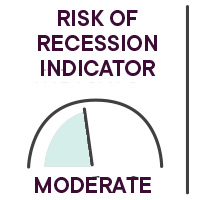Yann Furic
B.B.A., M. Sc., CFA®
Senior Portfolio Manager, Asset Allocation and Alternative Strategies
The recovery continues
The Canadian and U.S. stock markets are at record levels. Companies have started reporting their results for the second quarter of 2021 and they are very encouraging. Overall, sales and profits are exceeding expectations, and the market has revised upwards earnings forecasts for the next few quarters.
Focus on the past month

Overview of global equity markets*
- The flagship index of the Canadian stock market, the S&P/TSX, advanced 0.6% in July.
- In the United States, the S&P 500 gained 2.8% and the Nasdaq, 1.7%.
- International stock markets were also in positive territory during the month, with the EAFE Index up 1.3%.
- Emerging market equities fell 6.5% in July, dragged down by the 13.1% decline in Chinese stocks.
* All the percentages in this section are in Canadian dollars. Bloomberg unless otherwise indicated.
Key events

Evolution of COVID-19 and vaccination
Although world economies are growing well, the desynchronized vaccination campaigns between regions and countries are slowing the reopening of certain sectors of the economy, such as international tourism, and raising fears of possible partial returns to lockdown.
In North America, the rapid spread of the Delta variant is threatening the return to school of youngsters this fall. This situation could limit the availability of labour by requiring the presence of a parent at home for their children’s distance learning. The decrease in immigration resulting from border closures could also exacerbate this shortage.
Employment situation
In the United States, job creation was stronger than expected with a gain of 943,000 new jobs, while the forecast was for 870,000. Data for the previous month was also revised upwards, lowering the unemployment rate from 5.9% to 5.4%. The labour market participation rate rose from 61.6% to 61.7%.
In Canada, 94,000 jobs were added, versus expectations of 150,000. The unemployment rate fell 0.3% to 7.5%, while the labour market participation rate remained stable at 65.2%, compared to the forecast rate of 65.5%.
Corporate earnings
As the earnings forecasts for American companies have been revised upwards, the climate is positive for the markets.
Still in control
China said it wants to limit the influence of after-school tutoring companies, which puts additional financial pressure on families’ budgets. In recent months, the Chinese government’s measures have aimed to preserve social cohesion, while demonstrating an openness to capitalism. The state, however, wants to unequivocally affirm its control of power.
Results – Canadian bonds
Government of Canada bonds across maturities posted a positive return of 0.7% for the month. (Source: Canaccord Genuity)
Performance of our funds
View the returns

Our strategic monitoring
Main risks
Here are some risks that we are closely monitoring in the current environment.
- The cyclical recovery could be limited or delayed by various vaccine production problems, the speed of vaccination campaign rollouts, or the spread of a vaccine-resistant variant.
- A large-scale cyberattack could undermine the positive sentiment concerning the reopening of the global economy and consumer confidence.
- Inflation could rise sharply without corresponding economic growth, which would trigger an episode of stagflation.
- A sharp, rapid rise in interest rates would lower the price/earnings ratio, which would cause stock indices to fall.
- Governments could significantly increase corporate and personal tax rates to replenish their coffers. However, this scenario is unlikely in 2021.
Fundamental indicators
Some economic indicators that we continued to monitor in July:
Consumer confidence ![]()
For the fifth consecutive month, the Consumer Confidence Index was above 100 in July, hitting 129.1, the highest level since the start of the pandemic.
U.S. personal savings ![]()
The personal savings rate remains high, after a significant increase thanks to various government assistance programs. This money should be reinvested in the U.S. economy over the next few months as the economy and consumer spending return to normal.
Global Purchasing Managers’ Index ![]()
The index remains above 50, indicating an increase in purchasing managers’ intentions. At 55.4, the index is little changed from June’s 55.5 reading.
Benchmark rates in Canada, Europe and the United States ![]()
Rates remain at low levels, which is favourable for an economic recovery. This situation should continue until economies return to a satisfactory rate of growth and a low unemployment rate. Central banks are still willing to let inflation exceed targets before tightening their monetary policies, but rate hikes could come quicker than expected a few months ago, as the Fed’s forecasts demonstrate.
François Landry
CFA®
Vice-President and Chief Investment Officer
Vice-Chairman of the Board of Directors of Professionals' Financial - Private Management
Our strategies
(6-to-12 month horizon)
The strategic target for the FDP Tactical Asset Allocation Private Portfolio is 55% equities and 45% bonds. Based on our outlook, we have raised the tactical equity allocation to 69% and reduced the bond allocation to 31%.
The geographic allocation of equities in our portfolios shows greater exposure to cyclical sectors. We are overweight Canada, the EAFE zone and the United States. We have no position in emerging markets. Sector or factor positioning varies from region to region.
- In terms of Canadian equities, we have had a favourable bias towards banks for several months and we maintained our exposure to financial services. Canadian banks are still waiting for the regulatory go-ahead to raise their dividends and resume share buybacks in the next few months.
- Regarding U.S. equities, our exposure to stocks in the technology and industrial products sectors remains unchanged. We initiated a position in copper producers, as demand for this metal should benefit from announced infrastructure spending on renewable energies as well as increased demand for electric vehicles.
- As for the EAFE Index (Europe, Australasia, Far East), we have an overweight position due to the index’s greater exposure to more cyclical sectors. The fiscal and monetary measures introduced in Europe are less aggressive than those implemented in North America, but the zone should nevertheless benefit from an increase in commodity prices.
François Landry, CFA
Vice-President and Chief Investment Officer
Yann Furic, B.B.A., M. Sc., CFA
Senior Portfolio Manager, Asset Allocation and Alternative Strategies
Sources: Bloomberg
The opinions expressed here and on the next page do not necessarily represent the views of Professionals’ Financial. The information contained herein has been obtained from sources deemed reliable, but we do not guarantee the accuracy of this information, and it may be incomplete. The opinions expressed are based upon our analysis and interpretation of this information and are not to be construed as a recommendation. Please consult your Wealth Management Advisor.









